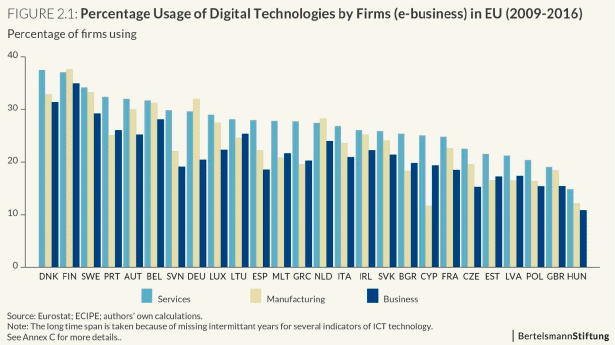
I’ve finally installed double glazing in my home. Two companies came to give me quotes. One company measured the size of the windows digitally. The information on the length and width of the windows was sent to their IT system which, together with the cost of the materials, produced a draft budget at once. I received the final quote five hours later. A second company also came to bid for the job. The measurements were done manually, the length and width of the windows were scribbled on a piece a paper. It took seven days for that company to send me its final quote.
This is digitalisation in real life, where some companies embrace digital technologies, whilst others do not.
In a recent study published by Bertelsmann Stiftung, we calculated the take-up of digital technologies across the European Union. As it can be seen in the Figure below, Spain is in the middle of the pack. But while Spanish services companies use more digital technologies than Italian or Dutch firms, Spain drops to the bottom of the ranking of digitalisation in manufacturing and business services.

But why does the adoption of digital technologies vary so much across countries and economic sectors? We put forward two explanations: regulatory barriers and competition.
First, restrictive policies in the digital and non-digital economy lower firms’ incentives to adopt digital technologies. Barriers in the digital economy work like an import tariff: they increase the price and reduce the number of digital technologies that companies can buy from abroad. Moreover, regulation aimed at the non-digital economy can impose certain restrictions that are incompatible with digital business models. Take the case of Germany, where all companies liable to pay taxes there must store their accounting documents and business letters in Germany. This regulation[1] effectively require accounting companies outside Germany to locate some of their business activities within Germany even if, thanks to digital technologies, accounting and book-keeping services can be delivered remotely.
Second, we found that digitalisation can support productivity growth for the firms with the lowest productivity and therefore closing the gap between the most and the least productive companies. However, the positive effects of digitalisation on productivity were completely wiped out when market concentration was too high.
These considerations are relevant in the Spanish context. Public policies to support the digitalisation of the economy must put the adoption of digital technologies at their centre. Our study found that, by incentivising companies to use digital technologies, market competition and lower digital and non-digital regulatory restrictions can support the digitalisation of the economy. This is paramount. It doesn’t matter how much it is invested in 5G and digital skills if companies do not use digital technologies in their daily work.
[1] Due to amendments in 2008 to the German Commercial Code – Section 257 No. 1 and 4 (Han-delsgesetzbuch § 257), all accounting documents and business letters must be stored in Germany. The breadth of the regulation was extended in 2012 through amendments to Tax Code – Section 146(2) 1 (Abgabenordnung, AO).

